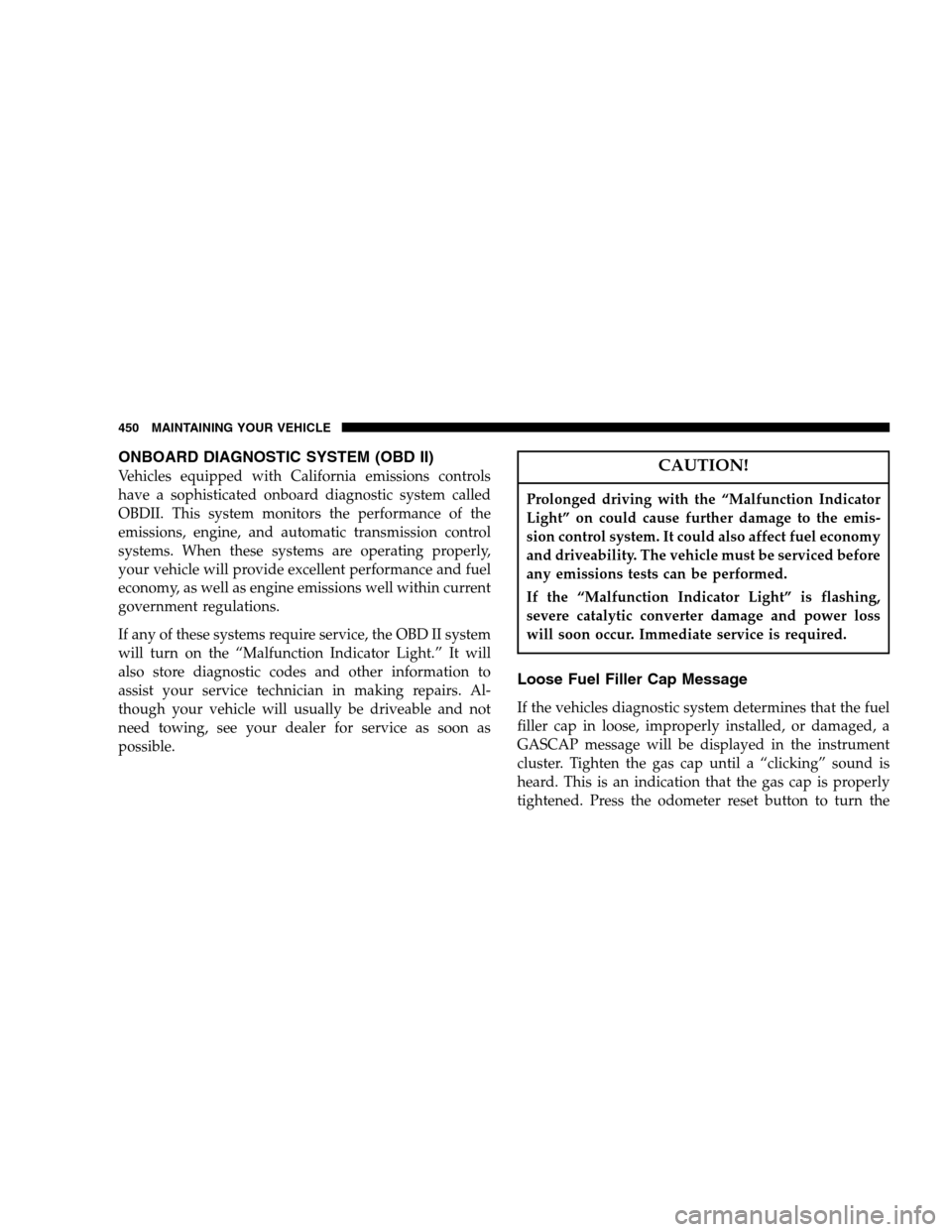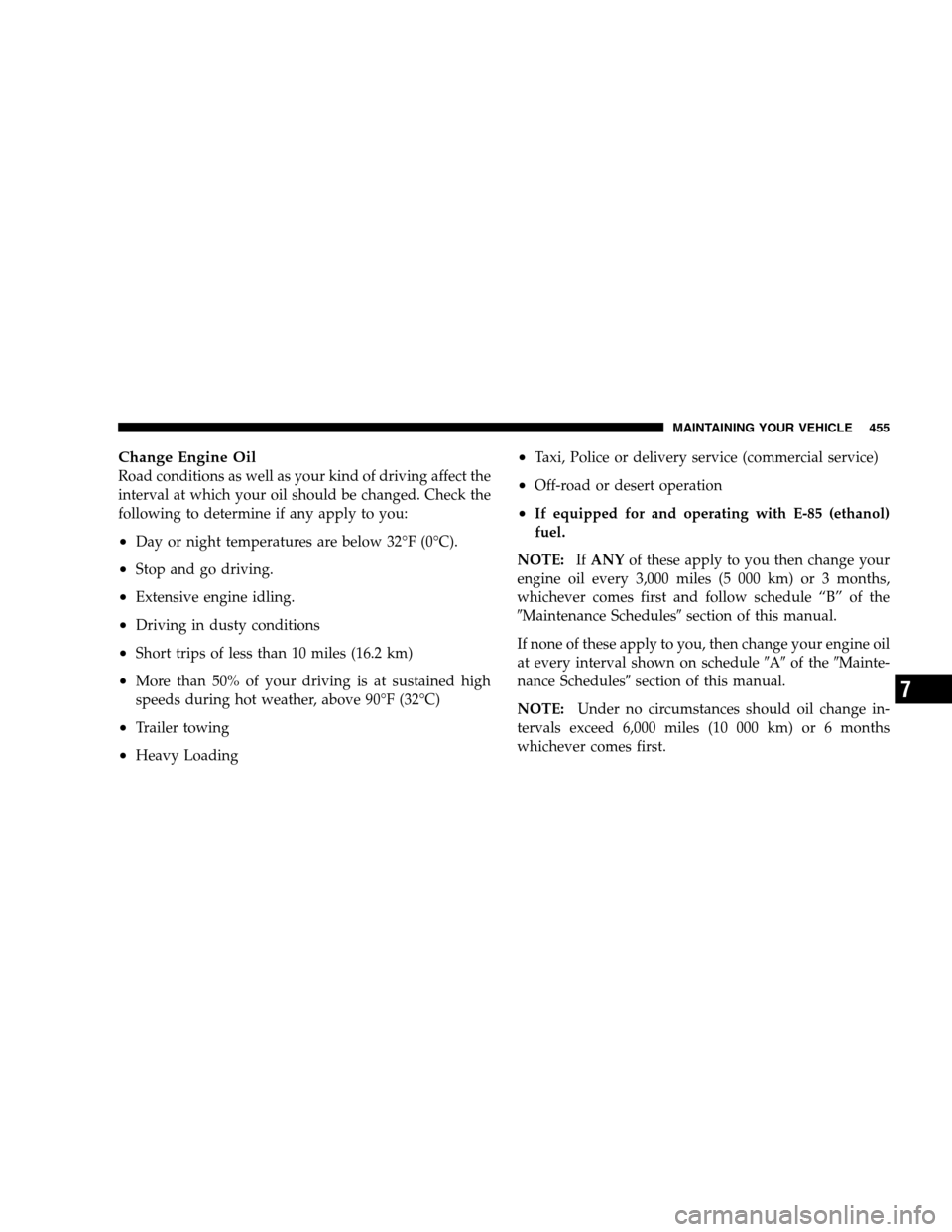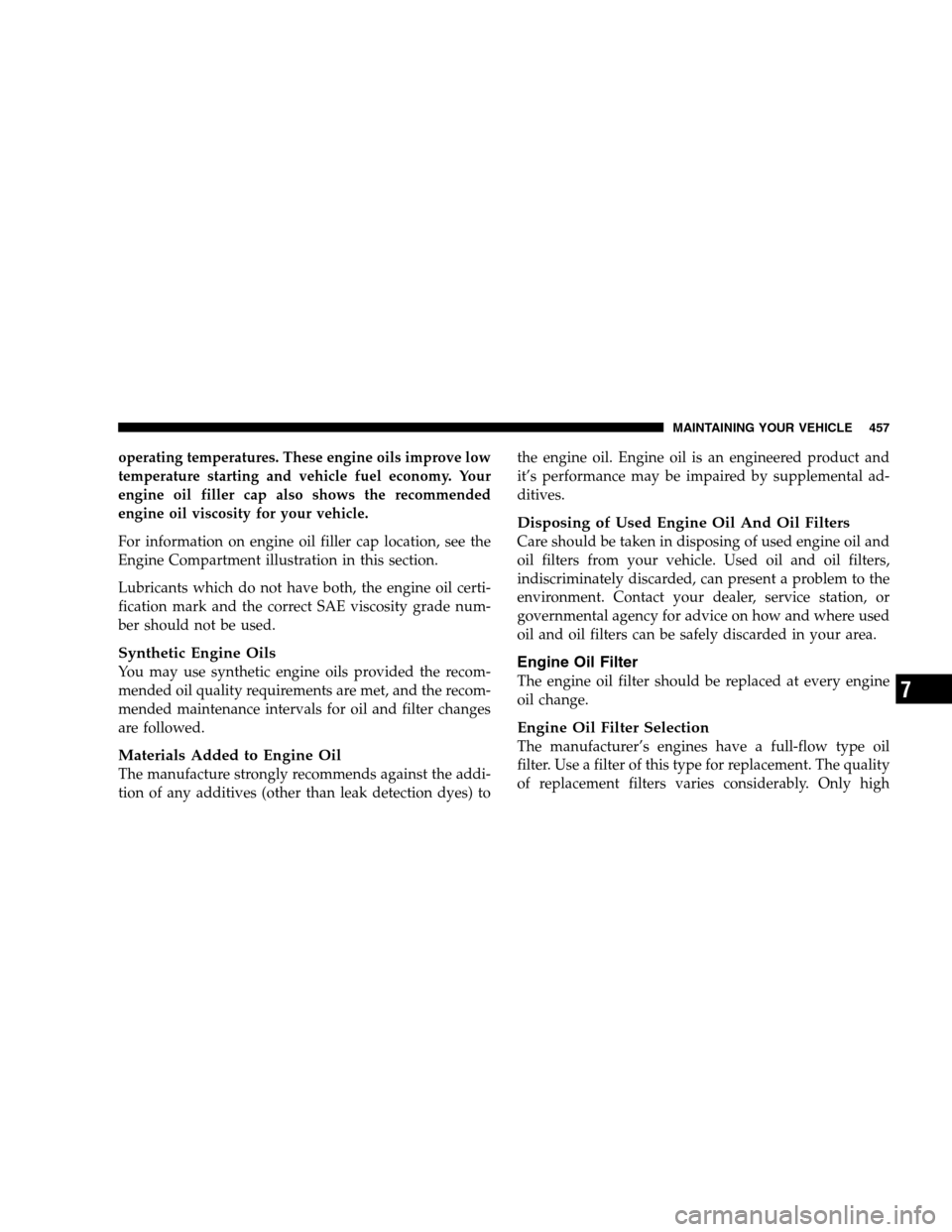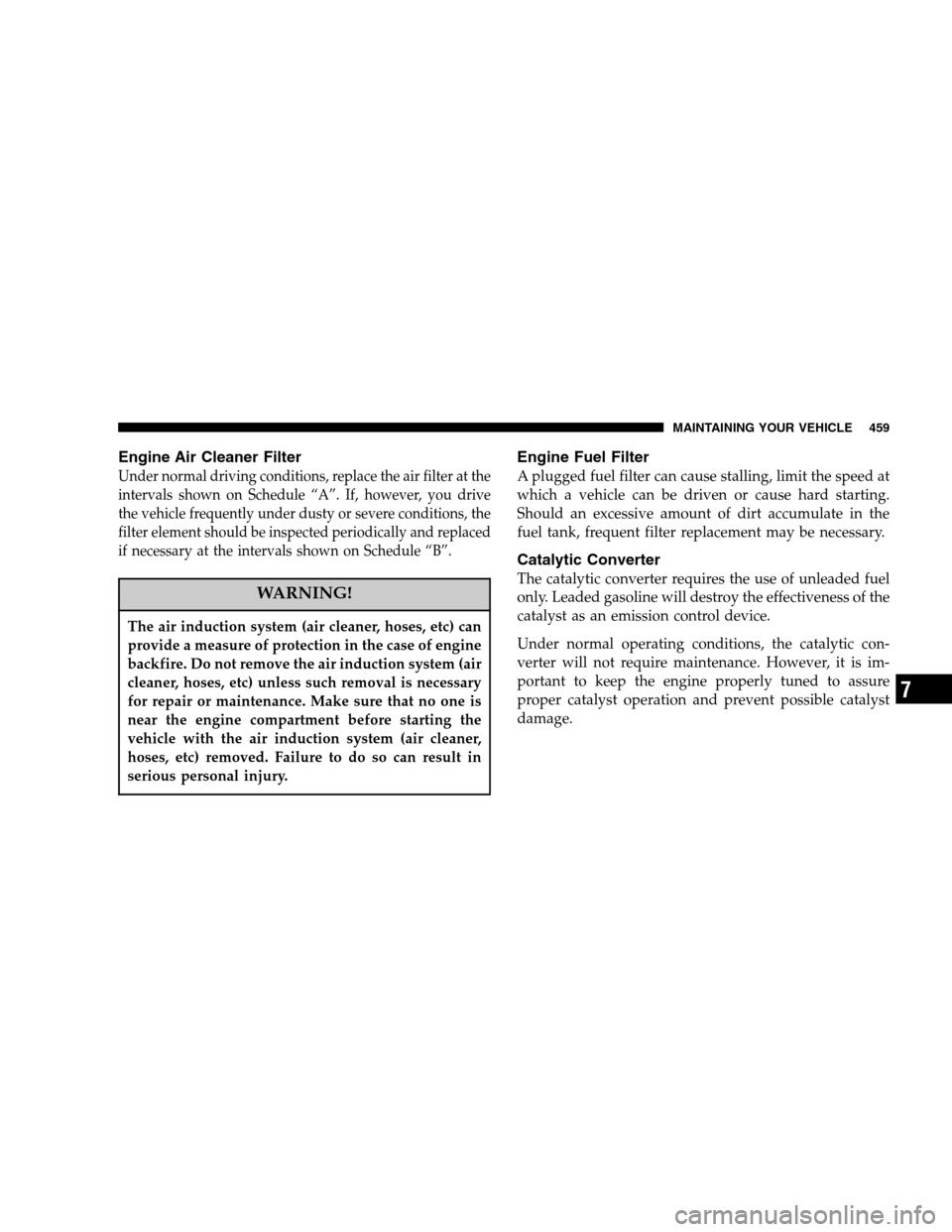Page 446 of 568

▫Maintenance Free Battery................461
▫Air Conditioner Maintenance.............463
▫Power Steering — Fluid Check............464
▫Front Suspension Ball Joints..............464
▫Steering Linkage — Inspection............465
▫Half-Shaft Constant Velocity Joints.........465
▫Front Prop Shaft Lubrication —
2500/3500 (4X4) Models................466
▫Body Lubrication.....................466
▫Windshield Wiper Blades................467
▫Windshield Washers...................467
▫Exhaust System......................468▫Cooling System.......................469
▫Hoses And Vacuum/Vapor Harnesses.......474
▫Fuel System Connections................474
▫Brake System........................475
▫Clutch Hydraulic System................477
▫Clutch Linkage.......................477
▫Rear Axle And 4X4 Front Driving Axle
Fluid Level..........................477
▫Transfer Case........................479
▫Manual Transmission..................479
▫Automatic Transmission................480
▫Front And Rear Wheel Bearings...........482
446 MAINTAINING YOUR VEHICLE
Page 450 of 568

ONBOARD DIAGNOSTIC SYSTEM (OBD II)
Vehicles equipped with California emissions controls
have a sophisticated onboard diagnostic system called
OBDII. This system monitors the performance of the
emissions, engine, and automatic transmission control
systems. When these systems are operating properly,
your vehicle will provide excellent performance and fuel
economy, as well as engine emissions well within current
government regulations.
If any of these systems require service, the OBD II system
will turn on the “Malfunction Indicator Light.” It will
also store diagnostic codes and other information to
assist your service technician in making repairs. Al-
though your vehicle will usually be driveable and not
need towing, see your dealer for service as soon as
possible.CAUTION!
Prolonged driving with the “Malfunction Indicator
Light” on could cause further damage to the emis-
sion control system. It could also affect fuel economy
and driveability. The vehicle must be serviced before
any emissions tests can be performed.
If the “Malfunction Indicator Light” is flashing,
severe catalytic converter damage and power loss
will soon occur. Immediate service is required.
Loose Fuel Filler Cap Message
If the vehicles diagnostic system determines that the fuel
filler cap in loose, improperly installed, or damaged, a
GASCAP message will be displayed in the instrument
cluster. Tighten the gas cap until a “clicking” sound is
heard. This is an indication that the gas cap is properly
tightened. Press the odometer reset button to turn the
450 MAINTAINING YOUR VEHICLE
Page 455 of 568

Change Engine Oil
Road conditions as well as your kind of driving affect the
interval at which your oil should be changed. Check the
following to determine if any apply to you:
•Day or night temperatures are below 32°F (0°C).
•Stop and go driving.
•Extensive engine idling.
•Driving in dusty conditions
•Short trips of less than 10 miles (16.2 km)
•More than 50% of your driving is at sustained high
speeds during hot weather, above 90°F (32°C)
•Trailer towing
•Heavy Loading
•Taxi, Police or delivery service (commercial service)
•Off-road or desert operation
•If equipped for and operating with E-85 (ethanol)
fuel.
NOTE:IfANYof these apply to you then change your
engine oil every 3,000 miles (5 000 km) or 3 months,
whichever comes first and follow schedule “B” of the
�Maintenance Schedules�section of this manual.
If none of these apply to you, then change your engine oil
at every interval shown on schedule�A�of the�Mainte-
nance Schedules�section of this manual.
NOTE:Under no circumstances should oil change in-
tervals exceed 6,000 miles (10 000 km) or 6 months
whichever comes first.
MAINTAINING YOUR VEHICLE 455
7
Page 457 of 568

operating temperatures. These engine oils improve low
temperature starting and vehicle fuel economy. Your
engine oil filler cap also shows the recommended
engine oil viscosity for your vehicle.
For information on engine oil filler cap location, see the
Engine Compartment illustration in this section.
Lubricants which do not have both, the engine oil certi-
fication mark and the correct SAE viscosity grade num-
ber should not be used.
Synthetic Engine Oils
You may use synthetic engine oils provided the recom-
mended oil quality requirements are met, and the recom-
mended maintenance intervals for oil and filter changes
are followed.
Materials Added to Engine Oil
The manufacture strongly recommends against the addi-
tion of any additives (other than leak detection dyes) tothe engine oil. Engine oil is an engineered product and
it’s performance may be impaired by supplemental ad-
ditives.
Disposing of Used Engine Oil And Oil Filters
Care should be taken in disposing of used engine oil and
oil filters from your vehicle. Used oil and oil filters,
indiscriminately discarded, can present a problem to the
environment. Contact your dealer, service station, or
governmental agency for advice on how and where used
oil and oil filters can be safely discarded in your area.
Engine Oil Filter
The engine oil filter should be replaced at every engine
oil change.
Engine Oil Filter Selection
The manufacturer’s engines have a full-flow type oil
filter. Use a filter of this type for replacement. The quality
of replacement filters varies considerably. Only high
MAINTAINING YOUR VEHICLE 457
7
Page 459 of 568

Engine Air Cleaner Filter
Under normal driving conditions, replace the air filter at the
intervals shown on Schedule “A”. If, however, you drive
the vehicle frequently under dusty or severe conditions, the
filter element should be inspected periodically and replaced
if necessary at the intervals shown on Schedule “B”.
WARNING!
The air induction system (air cleaner, hoses, etc) can
provide a measure of protection in the case of engine
backfire. Do not remove the air induction system (air
cleaner, hoses, etc) unless such removal is necessary
for repair or maintenance. Make sure that no one is
near the engine compartment before starting the
vehicle with the air induction system (air cleaner,
hoses, etc) removed. Failure to do so can result in
serious personal injury.
Engine Fuel Filter
A plugged fuel filter can cause stalling, limit the speed at
which a vehicle can be driven or cause hard starting.
Should an excessive amount of dirt accumulate in the
fuel tank, frequent filter replacement may be necessary.
Catalytic Converter
The catalytic converter requires the use of unleaded fuel
only. Leaded gasoline will destroy the effectiveness of the
catalyst as an emission control device.
Under normal operating conditions, the catalytic con-
verter will not require maintenance. However, it is im-
portant to keep the engine properly tuned to assure
proper catalyst operation and prevent possible catalyst
damage.
MAINTAINING YOUR VEHICLE 459
7
Page 474 of 568

•Do not change the thermostat for summer or winter
operation. If replacement is ever necessary, install
ONLY the correct type thermostat. Other designs may
result in unsatisfactory coolant performance, poor gas
mileage, and increased emissions.
Hoses And Vacuum/Vapor Harnesses
Inspect surfaces of hoses and nylon tubing for evidence
of heat and mechanical damage. Hard or soft spots,
brittle rubber, cracking, tears, cuts, abrasions, and exces-
sive swelling indicate deterioration of the rubber.
Pay particular attention to those hoses nearest to high
heat sources such as the exhaust manifold. Inspect hose
routing to be sure hoses do not come in contact with any
heat source or moving component which may cause heat
damage or mechanical wear.
Insure nylon tubing in these areas has not melted or
collapsed.Inspect all hose connections such as clamps and cou-
plings to make sure they are secure and no leaks are
present.
Components should be replaced immediately if there is
any evidence of wear or damage that could cause failure.Fuel System Connections
Electronic Fuel Injection high pressure fuel systems are
designed with tubes and special connects, connections
and clamps which have unique material characteristics to
provide adequate sealing and resist attack by deterio-
rated gasoline.
You are urged to use only the manufactures-specified
tubes, connections and clamps, or their equivalent in
material and specification, in any fuel system servicing.
474 MAINTAINING YOUR VEHICLE
Page 512 of 568
FLUIDS AND CAPACITIES
U.S. Metric
Fuel (Approximate)
3.7L/4.7L
5.7L
1500 Shortbed Models 26 gal. 98L
1500 Longbed Models 35 gal. 132L
1500 Shortbed Models 34 gal. 128L
2500 Shortbed Models 34 gal. 128L
2500 Longbed Models 35 gal. 132L
3500 Shortbed Models 34 gal. 128L
3500 Longbed Models 35 gal. 132L
Engine Oil (with filter)
3.7L Engine V-6 (SAE 5W-30, API Certified) 5.0 qts. 4.7L
4.7L Engine V-8 (SAE 5W-30, API Certified) 6.0 qts. 5.7L
512 MAINTAINING YOUR VEHICLE
Page 514 of 568
FLUIDS, LUBRICANTS AND GENUINE PARTS
Engine
Component Fluids, Lubricants and Genuine Parts
Engine Coolant Mopar�Antifreeze/Coolant 5 Year/100,000 Mile Formula HOAT (Hybrid Or-
ganic Additive Technology) or equivalent.
3.7/4.7L Engine Oil Use SAE 5W-30, API Certified, meeting material standard MS-6395.
5.7L Engine Oil (For trucks operat-
ing under a gross combined
weight ratinglessthan 14,000 lbs.)Use SAE 5W-20, API Certified, meeting material standard MS-6395.
5.7L Engine Oil (For 2500/3500
trucks operating under a gross
combined weight ratinggreater
than 14,000 lbs.)Use SAE 5W-30, API Certified, meeting material standard MS-6395.
Engine Oil Filter Mopar�Engine Oil Filter, P/N 5281090 or equivalent.
Spark Plugs Refer to the Vehicle Emission Control Information label in the engine com-
partment.
Fuel Selection (all except 5.7L) 87 Octane, (R+M)/2 Method
Fuel Selection (5.7L) 89 Octane, (R+M)/2 Method, Mid-Grade Preferred (87 Octane acceptable)
514 MAINTAINING YOUR VEHICLE